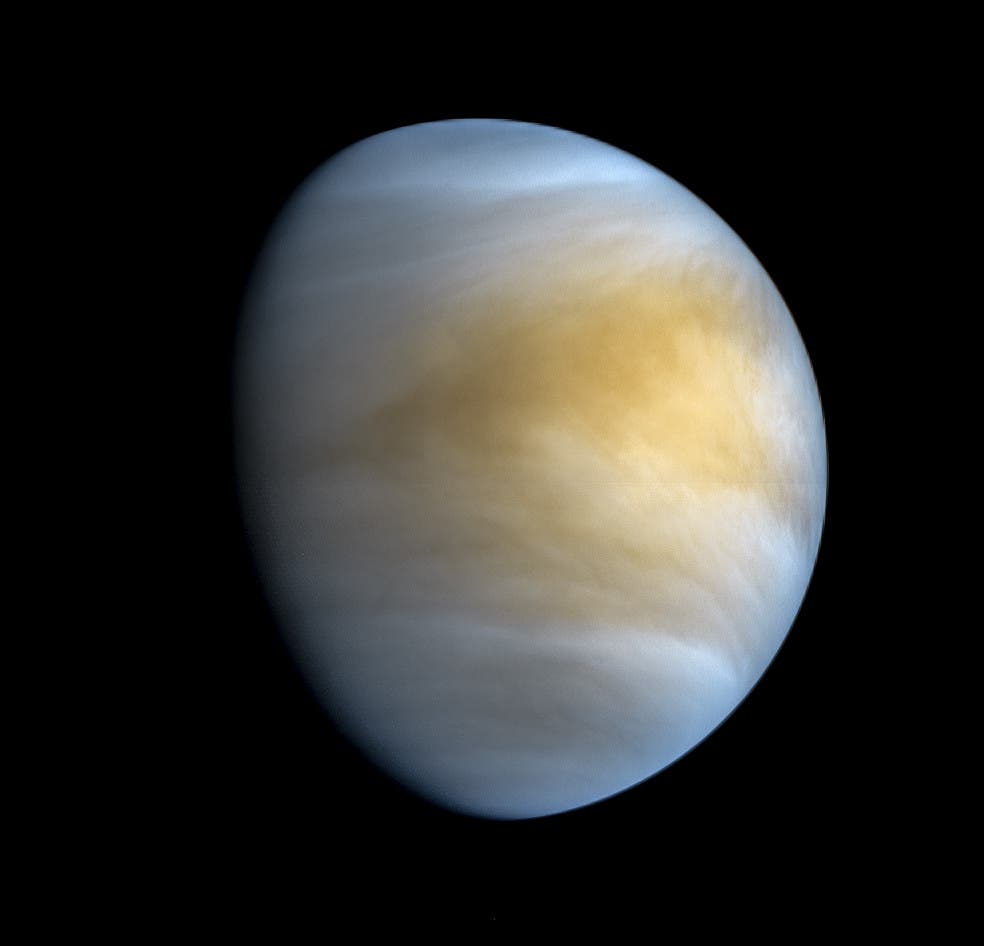
JAXA/ISAS/DARTS/Kevin M. Gill
The hell-scape that is Venus has an average surface temperature of 863° Fahrenheit (462° Celsius). The probe that lasted the longest in its atmosphere, Venera 12, survived for a grand total of two hours and seven minutes. To give you an idea why: the planet’s skies are made of clouds of sulphuric acid.
However, despite all of that, recent research has found that its climate may have been very different in the distant past.
Scientists from the Europlanet Society presented their study at the EPSC-DPS Joint Meeting 2019 in Geneva, Switzerland, and suggested that Venus may once have had a habitable climate — which could have sustained life around 700 million years ago. The livable habitat was prevalent for two to three billion years until rudely interrupted by a mysterious resurfacing event which transformed the landscape to its present condition.
Researchers Michael Way and Anthony Del Genio of the Goddard Institute for Space Science created five climate simulations to show what Venus’ environment would have been like, each one based on a different level of water coverage. Three of the five scenarios used the topography of today’s Venus — one with a deep ocean averaging 310 meters (1,017 feet), another with a shallow layer of water averaging 10 meters (33 feet) deep, and a third with a small volume of water locked in the soil. The remaining two scenarios used Earth’s topography — one with a 310 meters (1,017 feet) ocean and one completely covered by a 157-meter (518-foot) ocean. The model accounted for changes in atmospheric composition and solar radiation.
All simulations suggested that Venus may have been able to maintain stable temperatures, ranging from a low of 68° Fahrenheit (20° Celsius) to a high of 122° Fahrenheit (50° Celsius).
“Our hypothesis is that Venus may have had a stable climate for billions of years,” said Way. “It is possible that the near-global resurfacing event is responsible for its transformation from an Earth-like climate to the hellish hot-house we see today.”
“Venus currently has almost twice the solar radiation that we have at Earth. However, in all the scenarios we have modeled, we have found that Venus could still support surface temperatures amenable for liquid water.”
To simulate the environmental conditions at 4.2 billion years ago, 715 million years ago, and today, the researchers adapted a 3-D general circulation model to account for the increase in solar radiation as our Sun has warmed up over its lifetime, as well as for changing atmospheric compositions.
At 4.2 billion years ago, soon after its formation, the second planet from the Sun would have completed a period of rapid cooling and its atmosphere would have been dominated by carbon-dioxide. If Venus evolved in an Earth-like way over the next three billion years, the carbon dioxide would have been drawn down by silicate rocks and locked into the surface. By the second epoch, modeled at 715 million years ago, the atmosphere would likely have been dominated by nitrogen with trace amounts of carbon dioxide and methane — similar to the Earth’s today — and these conditions could have remained stable up until present times.
The cause of the outgassing which led to the transformation of the planet is still up for debate. However, it is most likely linked to the planet’s volcanic activity. One possibility is that large amounts of magma bubbled up, which released carbon dioxide from molten rocks into the atmosphere. The magma solidified before reaching the surface which created a barrier that meant the gas could not be reabsorbed. The presence of large amounts of carbon dioxide triggered a runaway greenhouse effect, that has resulted in the temperatures found on Venus today.
“Something happened on Venus where a huge amount of gas was released into the atmosphere and couldn’t be re-absorbed by the rocks,” said Way. “On Earth we have some examples of large-scale outgassing, for instance the creation of the Siberian Traps 500 million years ago which is linked to a mass extinction, but nothing on this scale. It completely transformed Venus.”
If they are correct, it means that Venus could have once supported life and that planets which we currently consider inhabitable due to close proximity to their stars might have once evolved in the same fashion.




